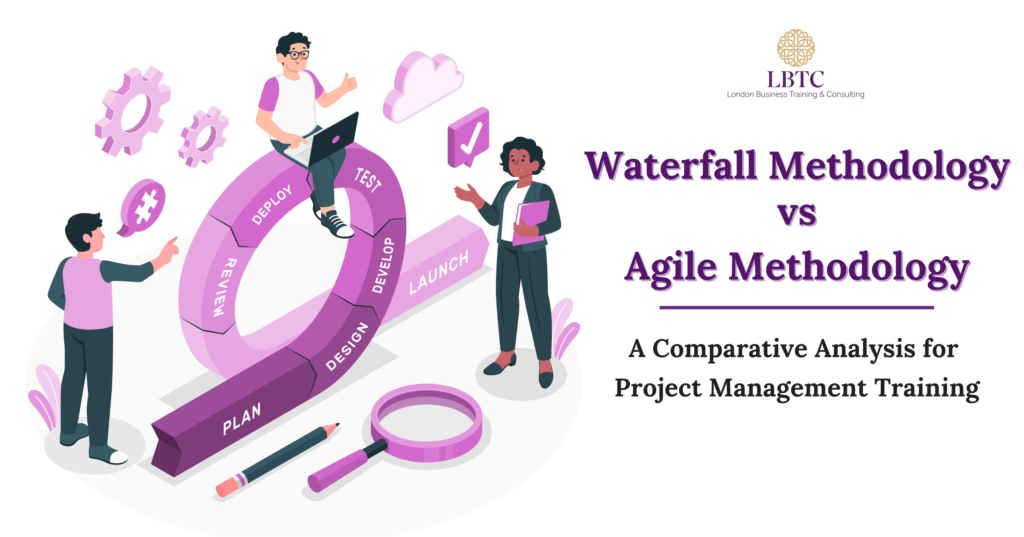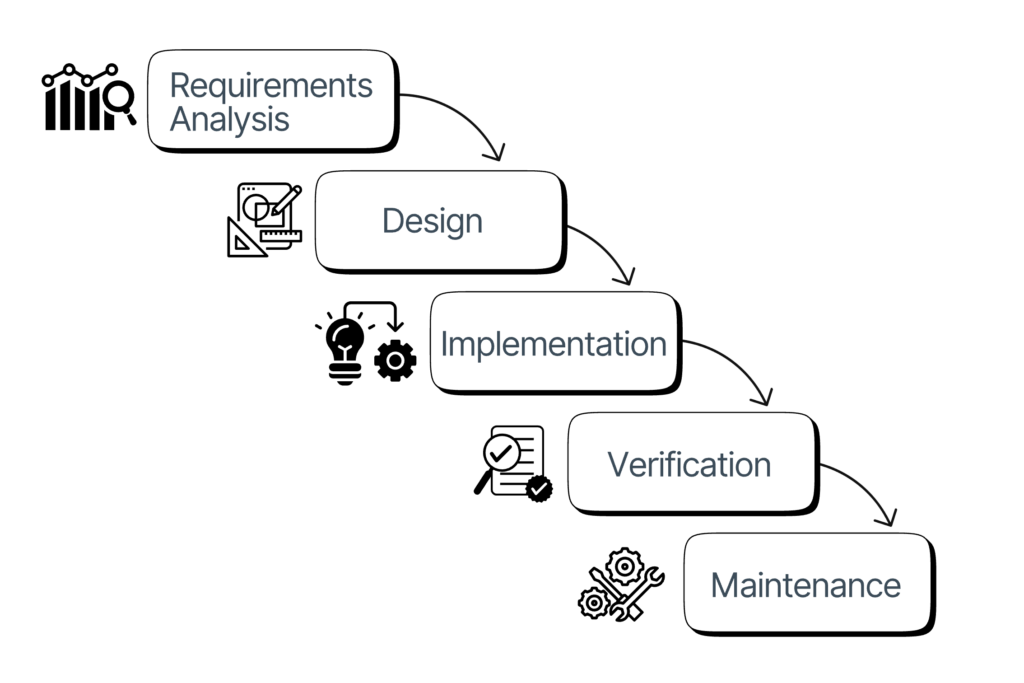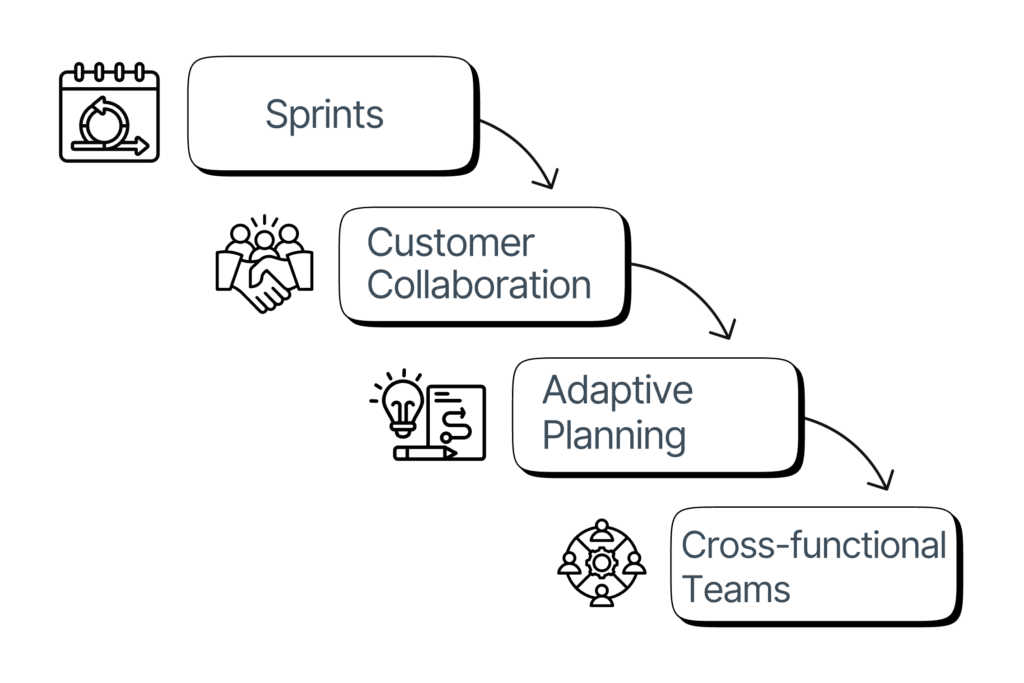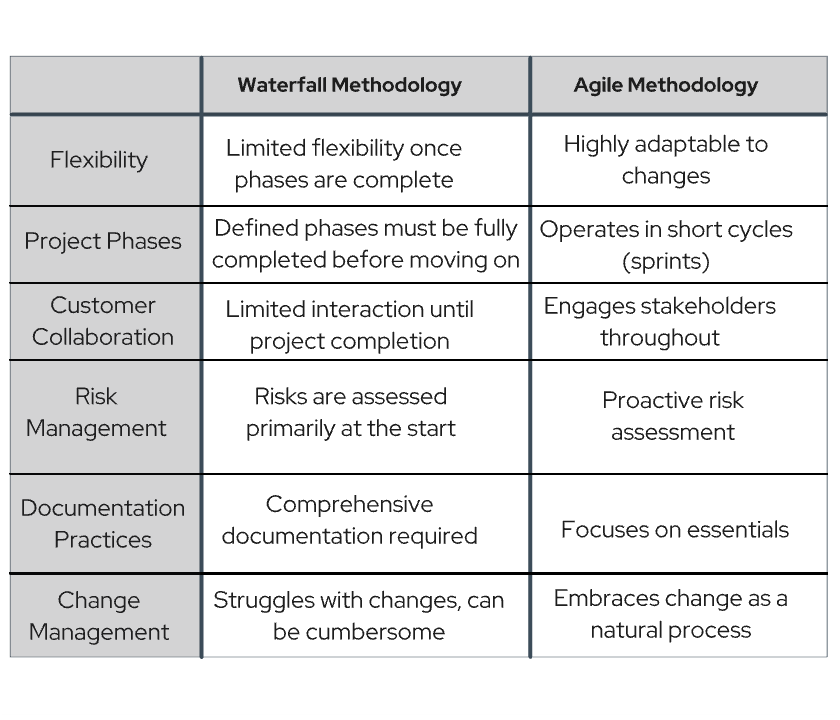
For the successful execution of a project, choice of either agile or waterfall methodology based on project complexity would increase the chances of project success.
This blog aims to compare these two approaches, helping you decide which is best suited for your PM training, especially when focused on specific fields such as Transportation Management.
“Excellent firms don’t believe in excellence – only in constant improvement and constant change.” – Tom Peters (Project Management Expert)
Visão geral das metodologias
O que é a metodologia em cascata? Assim, a abordagem do projeto é linear e seqüencial. Planos.
In Waterfall methodology, a project is divided into distinct phases, where each phase depends on the deliverables of the previous phase. Thus, the approach to the project is linear and sequential.
The main phases typically include:
Requirements Gathering: Documentation of final project outcomes.
Design: Creating detailed specifications for the project.
Implementation: Building the project according to the agreed-upon plans.
Verificação: Testando e validando o projeto contra seus requisitos. É particularmente eficaz para projetos com requisitos claros e imutáveis, facilitando a avaliação do progresso e o controle de alterações. A metodologia ágil é uma abordagem flexível projetada para acomodar os requisitos de mudança por meio de qualquer número necessário de iterações. O Agile enfatiza a colaboração, o feedback do cliente e a melhoria contínua ao longo do processo de desenvolvimento.
Maintenance: Ongoing support and updating after project delivery.
The Waterfall model is defined by its structured approach and emphasis on documentation. It is particularly effective for projects with clear, unchanging requirements, making it easier to gauge progress and control changes.

What is Agile Methodology?
In contrast, Agile methodology emphasises continuous improvement based on customer feedback, achieved through strong collaboration with customers. Agile methodology is a flexible approach designed to accommodate changing requirements through any necessary number of iterations. Agile emphasizes collaboration, customer feedback, and continuous improvement throughout the development process.
Key features of Agile include:
Sprints: Defined features or functionalities are developed and delivered within time-boxed iterations.
Colaboração do cliente: O feedback é obtido das partes interessadas através do engajamento contínuo para implementar as alterações necessárias no projeto rapidamente. Inovação.
Adaptive Planning: Plans are revisited and adjusted based on feedback and evolving project needs.
Cross-functional Teams: Individuals from various disciplines collaborate to promote innovation.
A metodologia ágil é adequada para projetos em que a entrega rápida é priorizada ao acomodar os requisitos de mudança. Escolhido quando um projeto possui requisitos bem definidos e baixa complexidade, enquanto a metodologia ágil é usada quando um projeto é altamente complexo e as alterações são frequentes. Se o projeto tiver requisitos bem definidos e baixa complexidade, a cachoeira poderá ser mais adequada. Para projetos inerentemente complexos ou envolvem mudanças frequentes, o Agile geralmente se encaixa melhor. Se o sucesso do seu projeto depende da contribuição das partes interessadas em vários estágios, o Agile deve ser sua metodologia de escolha. A cascata, com suas fases estruturadas, pode levar a prazos mais longos, mas fornece clareza e previsibilidade. Se sua equipe estiver estruturada em silos separados, a cachoeira pode ser mais fácil de implementar. Por outro lado, se a previsibilidade e o controle sobre as mudanças forem fundamentais, a cascata provavelmente é a melhor escolha. A decisão sobre a qual escolher depende das necessidades específicas do projeto, da complexidade das tarefas envolvidas e dos requisitos de envolvimento das partes interessadas. Esta afirmação ilustra lindamente a essência de escolher a metodologia certa para seus projetos. Seja optando por ágil ou cascata, concentre -se na melhoria contínua, adaptabilidade e práticas recomendadas para navegar com sucesso nas complexidades do gerenciamento de projetos, particularmente em campos especializados como o transporte

Key Comparison Criteria:

Choosing the Right Methodology for Your Project Management
Factors to consider while deciding between Agile and Waterfall factors:
- Nature of the Project: Waterfall methodology is chosen when a project has well-defined requirements and low complexity, while Agile methodology is used when a project is highly complex, and changes are frequent. If the project has well-defined requirements and low complexity, Waterfall may be more suitable. For projects that are inherently complex or involve frequent changes, Agile is often a better fit.
- Stakeholder Engagement: Agile thrives on continuous collaboration with stakeholders, making it ideal for projects where customer feedback is critical. If your project’s success hinges on stakeholder input at various stages, Agile should be your methodology of choice.
- Timeline and Delivery: If you require a rapid delivery cycle or plan to release the product in stages, Agile’s iterative approach is advantageous. Waterfall, with its structured phases, may lead to longer timelines but provides clarity and predictability.
- Team Structure: Agile works best in environments where cross-functional teams can collaborate effectively. If your team is structured into separate silos, Waterfall may be easier to implement.
- Risk Tolerance: If your organization can tolerate risks and uncertainties associated with evolving requirements, Agile may be preferable. Conversely, if predictability and control over changes are paramount, Waterfall is likely the better choice.
Conclusion: While Agile and Waterfall’s methodologies have their distinct advantages and drawbacks, understanding their differences is crucial for effective PM training. The decision on which to choose depends on the specific needs of the project, the complexity of tasks involved, and stakeholder engagement requirements. This statement beautifully illustrates the essence of choosing the right methodology for your projects. Whether opting for Agile or Waterfall, focus on continuous improvement, adaptability, and best practices to navigate the complexities of project management successfully, particularly in specialised fields like Transportation
Gerenciamento. Ao equipar sua equipe com o conhecimento de ambas as metodologias, você pode promover gerentes de projetos qualificados e versáteis prontos para enfrentar diversos desafios em suas carreiras. Qual você acha que seria mais eficaz para os projetos de sua equipe? Gostaríamos de ouvir suas idéias! Scrum
What are your thoughts on the Agile and Waterfall methodologies? Which one do you think would be more effective for your team’s projects? We’d love to hear your insights!

Deixe uma resposta